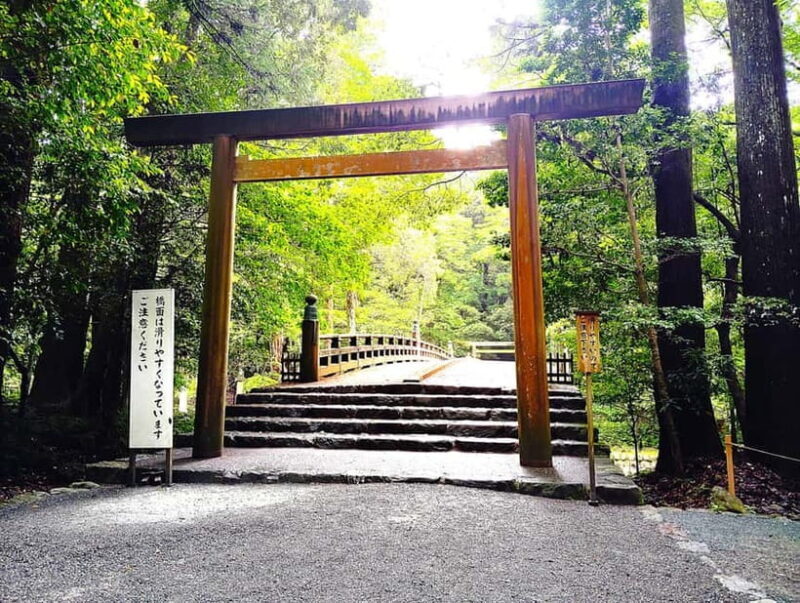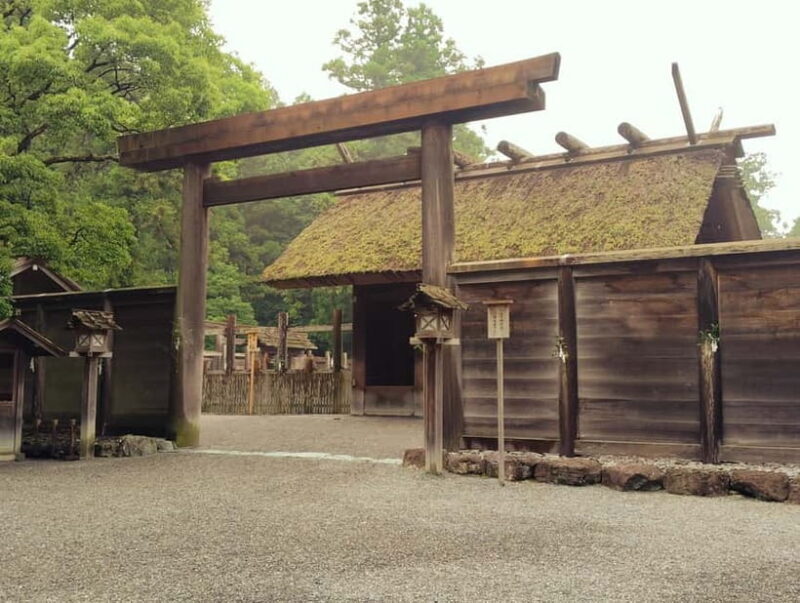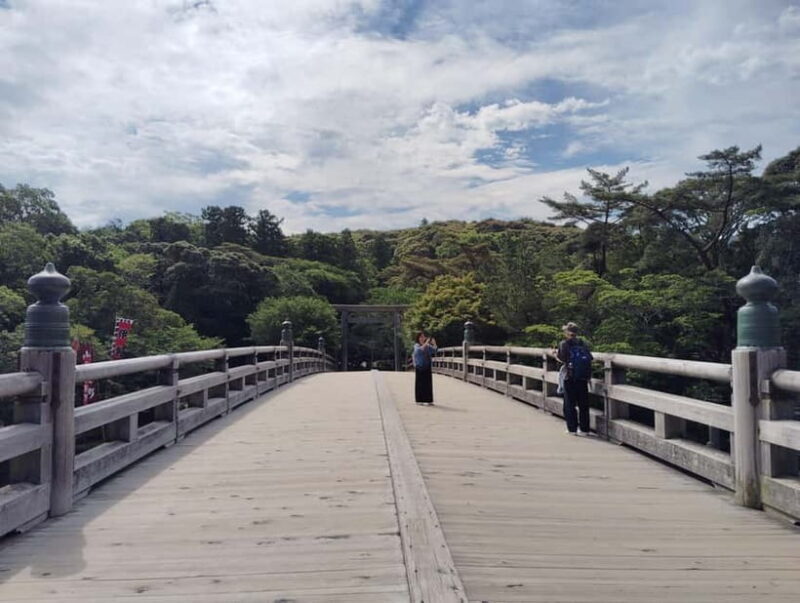Imagine walking through centuries of tradition, surrounded by towering cryptomeria trees and ancient cypress structures, all within the sacred grounds of Ise Jingū. For just $97, you get a detailed, guided exploration of Japan’s most revered shrines—the Outer Geku and the Inner Naiku—plus a stroll through the historic streets of Oharaimachi. Led by an expert local guide, this tour offers a deep dive into Japan’s spiritual core, combining cultural insight, striking architecture, and authentic local flavors.
What we love about this experience is how accessible and authentic it feels. First, the chance to stand on the Uji Bridge with its view into the tranquil Inner Shrine is a highlight that stays with us. Second, the opportunity to learn about the 20-year shrine rebuilding tradition (shikinen seng) reveals a living practice that emphasizes renewal and continuity. However, one consideration is that the tour involves quite a bit of walking through hallowed, sometimes shaded, areas—comfortable shoes are a must. This experience suits curious travelers who appreciate history, culture, and spirituality and want a guided, comprehensive introduction without feeling rushed.
Key Points

- Cultural Depth: The tour offers an in-depth look at the religious and architectural significance of Ise Jingū.
- Authentic Experience: Walking through historic streets like Oharaimachi provides a taste of traditional Japan.
- Insight into Rituals: Learn about unique traditions like the shrine’s rebuilding every 20 years.
- Flexibility: Options include train ticket upgrades, making travel more comfortable.
- Value: At $97, it provides a comprehensive, guided experience that’s well worth the cost.
- Practicality: Designed for those comfortable with walking and exploring sacred sites.
Visiting Japan’s Spiritual Heart: What to Expect

Planning more time in Ise Japan? We've covered other experiences worth considering.
Starting at the Outer Shrine (Geku)
Your journey begins at the Outer Shrine, Geku, dedicated to Toyouke-mikami, the goddess of food, clothing, and shelter. This site’s quiet dignity, set amid tall cryptomeria trees, immediately sets a mood of calm reverence. We loved the way the towering trees seem to whisper stories of the past, quietly reinforcing the Shinto ideal of harmony with nature. The shrine buildings, simple yet elegant, reflect a deep respect for tradition and natural materials.
Your guide will explain the significance of the shrine’s architecture and rituals, including the daily offerings and the unique tradition of shikinen seng—the practice of rebuilding the shrine every 20 years. This cycle, rooted in the belief of tokowaka or eternal youth, emphasizes renewal and the perpetuity of life. Watching the artisans carefully reconstruct the structures using traditional techniques is a reminder of Japan’s dedication to craftsmanship and cultural preservation.
Crossing the Uji Bridge to the Inner Shrine (Naiku)
Next, you’ll cross the Uji Bridge, a symbolic threshold into the Inner Shrine (Naiku)—the spiritual centerpiece of Ise Jingū. Here, the atmosphere shifts from open forest to a hushed, almost sacred silence. The Naiku is dedicated to Amaterasu, the sun goddess, and the revered ancestor of Japan’s Imperial family. The hinoki cypress construction—built entirely without nails—speaks volumes about Japanese woodworking mastery and reverence for natural materials.
The shrine’s gravel paths and towering trees foster a sense of timelessness. We found ourselves contemplating the continuity of worship that has persisted for over two thousand years. Standing at this serene site, it’s impossible not to feel the weight of history and the importance of traditions that have survived countless centuries.
Exploring Oharaimachi
After soaking in the spiritual atmosphere, your guide will lead you into Oharaimachi, the historic street that once served pilgrims on their journey to Ise Jingū. Today, it’s a lively but charming area full of wooden facades, traditional shops, and snack stalls. Here, you can sample Akafuku mochi, a local delicacy that’s smooth, sweet, and almost melt-in-your-mouth, or try the fragrant Miso-glazed Dango—a simple, satisfying treat.
The streets evoke a sense of stepping back in time. As one reviewer noted, “The preserved wooden facades and cobbled alleys make you feel like you’ve traveled into a different era.” It’s a perfect place to experience authentic local flavors, local craftsmanship, and the quiet pride of a community that still celebrates its spiritual and cultural roots.
More Great Tours NearbyPractical Details: Making the Most of Your Visit

Transportation and Timing
The tour price includes an option for reserved-seat limited express train tickets from Nagoya to Ise, making the journey comfortable and hassle-free. If you opt out, you’ll need to arrange your own transport, which is manageable but adds a layer of planning. The tour typically involves a full day of walking, so wear comfortable shoes and be prepared for some weather exposure—whether sun or rain.
Tour Length and Group Size
The tour is designed to be comprehensive but manageable, usually lasting several hours, with plenty of time for photos, questions, and relaxed exploration. Group sizes tend to be small enough for personal interaction but large enough to feel lively and engaging.
Pricing and Value
At $97 per person, this guided experience offers excellent value—especially considering it includes expert insights, detailed explanations, and exclusive access to some sacred sites. Plus, the chance to taste local snacks and walk through historic streets adds a layer of authentic experience that self-guided visits can’t match.
Accessibility and Considerations
While the tour involves some walking over uneven surfaces and through sacred sites, it is suitable for most travelers in decent health. Be mindful of weather conditions, and bring essentials like a camera, water, and weather-appropriate clothing.
Why This Tour Works Well

This experience is ideal for travelers who want more than just a superficial visit to Ise Jingū. If you appreciate cultural storytelling, traditional architecture, and authentic local flavors, this guided tour offers a balanced mix. It’s particularly suited for those who enjoy the quiet dignity of religious sites and are open to learning about Japan’s deep-rooted traditions like the 20-year shrine reconstruction.
Final Thoughts

This guided tour of Ise Jingū’s Outer and Inner Shrines offers a well-rounded, meaningful glimpse into Japan’s spiritual tradition. The combination of architectural marvels, ritual insights, and charming local streets provides a rich experience for culturally curious travelers. It’s a chance to connect with a living tradition that has shaped Japanese identity for over two millennia—without feeling like you’re rushing through a checklist.
While some may prefer a more flexible, self-guided visit, the guided element enriches the experience with stories, context, and expert knowledge you won’t find in a lonely wander. If you’re visiting Honshu and want an authentic, rewarding day immersed in Japan’s sacred landscape, this tour is definitely worth considering.
FAQ

What is included in the tour?
The tour covers guided visits to both the Outer Shrine (Geku) and the Inner Shrine (Naiku), a walk through Oharaimachi, and an expert local guide. There’s also an option for reserved-seat train tickets from Nagoya to Ise.
How long does the tour last?
The tour usually lasts several hours, providing enough time to explore the shrines, walk through the streets, and enjoy some local snacks.
Is transportation arranged?
Yes, there is an option to include train tickets from Nagoya, making the trip easier. Otherwise, you can arrange your own transportation.
What should I bring?
Comfortable walking shoes are a must. Also, bring a camera, weather-appropriate clothing, and some cash for snacks or souvenirs.
Are there any restrictions on access?
The tour involves walking through historic and sacred sites, so be prepared for uneven paths and possibly shaded areas.
Can I cancel if my plans change?
Yes, you can cancel up to 24 hours in advance for a full refund, offering flexibility for your travel plans.
Is the tour suitable for children?
Most likely yes, especially if they can handle some walking and appreciate cultural sites, but check with the provider if you have specific concerns.
What makes this tour special?
It combines the spiritual significance of Japan’s most sacred shrines with a walk through historic streets, offering a comprehensive and authentic experience that’s both educational and enjoyable.
This tour offers a meaningful way to understand Japan’s spiritual traditions while enjoying its beautiful architecture and welcoming local culture. It’s perfect for those who want a guided, insightful journey that’s both accessible and enriching.
You can check availability for your dates here: